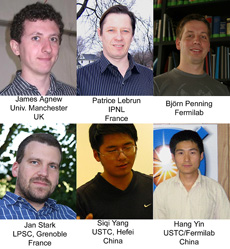| Thursday, Dec. 16, 2010 |
| Subscribe | Contact Fermilab Today | Archive | Classifieds |
Result of the Week
|
The strong nuclear force influences only particles that carry the strong charge, which we call color. Color is similar to the more familiar electric charge. Just as objects can be electrically neutral (i.e. have no net electric charge), objects can also be color neutral. Protons are color neutral. However, protons consist of three particles called quarks, and quarks do have color. The colors of the three quarks cancel each other out to make the proton color neutral. It’s a little like how a positive and negative electric charge can cancel each other and produce a neutral particle. In Tevatron collisions, protons collide with antiprotons. When that happens, a quark is knocked out of the proton and into our detector. Because the quark has color, and the proton doesn’t, the two remaining quarks that continue to travel the beam pipe must have the opposite color. We can simplify this if we think of the quark and proton debris as two particles with opposite nuclear charge, moving away from each other; one into the detector and one down the beam pipe. When two objects of opposite color are pulled apart, the force between them increases. The strong force doesn’t act like two magnets being pulled apart, where the force decreases with distance, but instead more like a rubber band. The two color-carrying particles are the ends of the rubber band or a stretchy bracelet, while the stretchy stuff in the middle is the energy of the strong force. At large distances, the force becomes constant, while retaining the other properties of a rubber-band-like force. The energy stored in the rubber band increases as the particles separate. Eventually this energy is converted into many particles. These particles move along in the general direction of the original quarks and form jets. But because of the force's rubber-band-like nature, the particles in the jets usually appear in the region between the directions of the two quarks. This is a prediction of quantum chromodynamics, which is the most successful theory of strong force interactions. To study this phenomenon, DZero physicists turned to an unlikely source: top quark events. Top quarks decay 100 percent of the time into bottom quarks and W bosons. W bosons have no color charge and decay most of the time into two quarks. Since these two quarks would have opposite color charge, studies of W bosons are an ideal place to study this QCD prediction. We can contrast this to more common scatterings between quarks, where color of the scattered quarks might be connected to either of the beams or other scattered quarks. By studying a dataset selected to enhance the fraction of top quark events, the researchers determined that the data was consistent with patterns expected from the decay of a color-neutral W boson, although the result was not definitive. Top quarks are rare, and the strength of this analysis will improve as more data is collected.-Don Lincoln |


